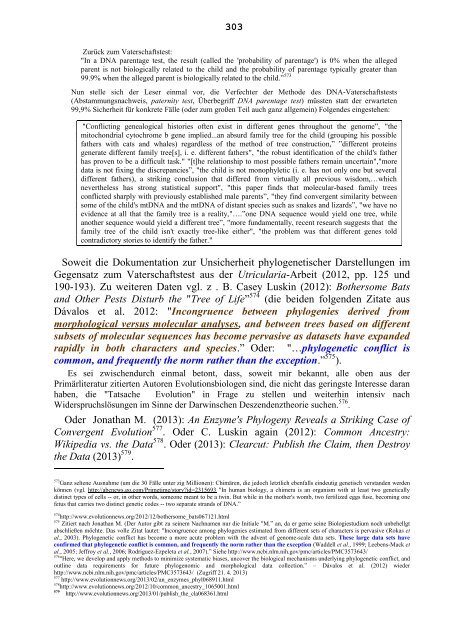Unser Haushund: Eine Spitzmaus im Wolfspelz? - Wolf-Ekkehard ...
Unser Haushund: Eine Spitzmaus im Wolfspelz? - Wolf-Ekkehard ...
Unser Haushund: Eine Spitzmaus im Wolfspelz? - Wolf-Ekkehard ...
Sie wollen auch ein ePaper? Erhöhen Sie die Reichweite Ihrer Titel.
YUMPU macht aus Druck-PDFs automatisch weboptimierte ePaper, die Google liebt.
303Zurück zum Vaterschaftstest:"In a DNA parentage test, the result (called the 'probability of parentage') is 0% when the allegedparent is not biologically related to the child and the probability of parentage typically greater than99.9% when the alleged parent is biologically related to the child.” 573Nun stelle sich der Leser einmal vor, die Verfechter der Methode des DNA-Vaterschaftstests(Abstammungsnachweis, paternity test, Überbegriff DNA parentage test) müssten statt der erwarteten99,9% Sicherheit für konkrete Fälle (oder zum großen Teil auch ganz allgemein) Folgendes eingestehen:"Conflicting genealogical histories often exist in different genes throughout the genome”, "themitochondrial cytochrome b gene <strong>im</strong>plied...an absurd family tree for the child (grouping his possiblefathers with cats and whales) regardless of the method of tree construction,” ”different proteinsgenerate different family tree[s], i. e. different fathers", "the robust identification of the child's fatherhas proven to be a difficult task." "[t]he relationship to most possible fathers remain uncertain","moredata is not fixing the discrepancies”, "the child is not monophyletic (i. e. has not only one but severaldifferent fathers), a striking conclusion that differed from virtually all previous wisdom,…whichnevertheless has strong statistical support", "this paper finds that molecular-based family treesconflicted sharply with previously established male parents”, "they find convergent s<strong>im</strong>ilarity betweensome of the child's mtDNA and the mtDNA of distant species such as snakes and lizards”, "we have noevidence at all that the family tree is a reality,"….”one DNA sequence would yield one tree, whileanother sequence would yield a different tree”, "more fundamentally, recent research suggests that thefamily tree of the child isn't exactly tree-like either", "the problem was that different genes toldcontradictory stories to identify the father."Soweit die Dokumentation zur Unsicherheit phylogenetischer Darstellungen <strong>im</strong>Gegensatz zum Vaterschaftstest aus der Utricularia-Arbeit (2012, pp. 125 und190-193). Zu weiteren Daten vgl. z . B. Casey Luskin (2012): Bothersome Batsand Other Pests Disturb the "Tree of Life” 574 (die beiden folgenden Zitate ausDávalos et al. 2012: "Incongruence between phylogenies derived frommorphological versus molecular analyses, and between trees based on differentsubsets of molecular sequences has become pervasive as datasets have expandedrapidly in both characters and species.” Oder: "…phylogenetic conflict iscommon, and frequently the norm rather than the exception.” 575 ).Es sei zwischendurch einmal betont, dass, soweit mir bekannt, alle oben aus derPr<strong>im</strong>ärliteratur zitierten Autoren Evolutionsbiologen sind, die nicht das geringste Interesse daranhaben, die "Tatsache Evolution" in Frage zu stellen und weiterhin intensiv nachWiderspruchslösungen <strong>im</strong> Sinne der Darwinschen Deszendenztheorie suchen. 576 .Oder Jonathan M. (2013): An Enzyme's Phylogeny Reveals a Striking Case ofConvergent Evolution 577 . Oder C. Luskin again (2012): Common Ancestry:Wikipedia vs. the Data 578 . Oder (2013): Clearcut: Publish the Cla<strong>im</strong>, then Destroythe Data (2013) 579 .573 Ganz seltene Ausnahme (um die 30 Fälle unter zig Millionen): Ch<strong>im</strong>ären, die jedoch letztlich ebenfalls eindeutig genetisch verstanden werdenkönnen (vgl. http://abcnews.go.com/Pr<strong>im</strong>et<strong>im</strong>e/story?id=2315693 "In human biology, a ch<strong>im</strong>era is an organism with at least two geneticallydistinct types of cells -- or, in other words, someone meant to be a twin. But while in the mother's womb, two fertilized eggs fuse, becoming onefetus that carries two distinct genetic codes -- two separate strands of DNA.”574 http://www.evolutionnews.org/2012/12/bothersome_bats067121.html575 Zitiert nach Jonathan M. (Der Autor gibt zu seinem Nachnamen nur die Initiale "M.” an, da er gerne seine Biologiestudium noch unbehellgtabschließen möchte. Das volle Zitat lautet: "Incongruence among phylogenies est<strong>im</strong>ated from different sets of characters is pervasive (Rokas etal., 2003). Phylogenetic conflict has become a more acute problem with the advent of genome-scale data sets. These large data sets haveconfirmed that phylogenetic conflict is common, and frequently the norm rather than the exception (Waddell et al., 1999; Leebens-Mack etal., 2005; Jeffroy et al., 2006; Rodríguez-Ezpeleta et al., 2007).” Siehe http://www.ncbi.nlm.nih.gov/pmc/articles/PMC3573643/576 "Here, we develop and apply methods to min<strong>im</strong>ize systematic biases, uncover the biological mechanisms underlying phylogenetic conflict, andoutline data requirements for future phylogenomic and morphological data collection.” – Dávalos et al. (2012) wiederhttp://www.ncbi.nlm.nih.gov/pmc/articles/PMC3573643/ (Zugriff 21. 4. 2013)http://www.evolutionnews.org/2013/02/an_enzymes_phyl068911.htmlhttp://www.evolutionnews.org/2012/10/common_ancestry_1065001.html579 http://www.evolutionnews.org/2013/01/publish_the_cla068361.html














